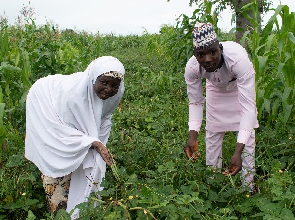Sunday, October 16, 2022, was World Food Day. The day is celebrated annually under the auspices of the United Nations to raise awareness about poverty, hunger, and the need to make adequate food available to all. As we mark the day, I want to talk about what is probably the most significant food security-related development Ghana has witnessed since we celebrated the last World Food Day in October 2021. It has to do with genetically modified (GM) foods which are popularly known as GMOs. In June 2022, Ghana approved it is first genetically modified crop for environmental release. The approval by the National Biosafety Authority (NBA) means the genetically modified pod borer resistant (PBR) cowpea or beans, can now be released from confined research fields where they have been under trial for several years now. The NBA - an entity set up by an act of Parliament under the Ministry of Environment, Science, Technology, and Innovation - has thus now given the GM cowpea the green light to go through the processes that all non-GM seed varieties go through at the Ministry for Food and Agriculture, and then it can be made commercially available to farmers. It’s taken scientists at the Savanna Agricultural Research Institute (SARI) of the Council for Scientific and Industrial Research almost 10 years to get approval from the NBA, making it a historic win for the institution. A 12-page decision document dated June 30, 2022, and published on the website of the Biosafety Clearing House says “the board of the NBA has determined that the genetically modified plant does not present an altered environmental risk or a food or feed safety concern when compared to conventional cowpea varieties in Ghana. The board has therefore approved the environmental release and placing on the market of the cowpea which has been genetically modified for resistance to Maruca pod borer for a ten (10) year period, renewable.” Important revelations The NBA in the decision document says the Bt gene used in creating the GM cowpea has a history of safe use in crops like maize in other parts of the world, including South Africa, the USA, and Europe. The authority says the genetic modification of the cowpea did not have unintended or unexpected effects on the plant’s growth habits. There were also no indications that the GM cowpea will be more invasive or persistent in the environment, or have altered susceptibility to pests and diseases compared to the conventional cowpea. Except for the intended resistance to Maruca pod borer, the GM cowpea is equivalent to conventional cowpea. The authority says the variety is unlikely to be toxic or allergenic to mammals, and it does not identify any new hazards associated with it. The NBA also says its assessment indicated there is no increased weediness or invasiveness potential compared to conventional cowpea varieties, and the potential risk of gene flow from the cowpea to wild relatives is negligible. It will not result in altered impacts on non-target organisms, including humans, and will not spread into or persist in unmanaged environments. The authority also says the GM cowpea does not pose an increased risk of interacting with non-target organisms, and the potential impact on biodiversity is equivalent to that of conventional cowpea varieties. The nutritional composition of GM cowpea is substantially equivalent to that of conventional cowpea varieties. One other important revelation in the NBA approval document is that the genetically modified PBR cowpea is not a hybrid. Just like other open-pollinated varieties, farmers can save GM cowpea seeds for planting the following season. What are GMOs? Genetically Modified Organism (GMO) is the common terminology that is used to describe crops and animals that have been created through genetic engineering procedures. For ages, plant breeders seeking to improve upon crops cross them on the field to move the desired traits to the crop of interest, usually within the same species. Traits like pest resistance, drought tolerance, improved nutritional values, and better yields, are common characteristics plant breeders work with. With GMOs, the gene or DNA responsible for the desired trait gets moved into the laboratory. Subsequent generations of the new seeds that get planted on the field inherit the newly introduced traits. In South Africa, more than 85% of all corn, and 90% of all soybean grown and consumed are GMOs. In the USA, more than 90% of both crops grown and consumed are GMOs. As at 2019, GMOs were grown in 29 different countries across the world. To date, there has been no evidence that the consumption of GMOs has caused any adverse health effects in human and animal consumers anywhere in the world. What does the GM cowpea do? Cowpea, popularly called beans is a popular, protein-rich crop that is consumed by millions in Ghana and the rest of Africa. But the crop is vulnerable to the Maruca pod borer pests. To control the pest, farmers typically spray their fields with pesticides between 8 and 12 times in the 8 to 12-week life cycle of the crop. The GM cowpea, which includes a gene from a naturally occurring soil bacterium known as Bt, is resistant to the pest. Confined field trials have shown that if farmers grow GM cowpea, they can reduce their spray regimen from at least 8 to just twice per season while gaining a five-fold increase in yield. Following the approval by the NBA, CSIR scientists are rolling out multilocational trials during which farmers will grow the GM cowpea in their own fields. The scientists will collect data on its performance, which will then be submitted to the Varietal Release Committee (VRC) of the Ministry of Food and Agriculture for varietal release approval before it can be made commercially available to farmers. Conclusion This is a very historic approval that puts Ghana in the league of countries like Nigeria, South Africa, the United States of America, Brazil, and more than 25 other countries where GMOs are grown. In August, a peer-reviewed study published by Dr. Graham Brookes of UK-based PG Economics revealed that between 1996 and 2020, the net global income farmers earned from adopting GM crops hit US$225 billion. GM technology used in maize increased yields by an average of 17.7 percent, relative to conventional production systems. GM technology also helped farmers reduce the environmental footprint associated with their crop protection practices by over 17%. It additionally helped avoid the destruction of more than 23 million hectares of farm fields to meet current global crop production levels. In other words, if GM technology had not been introduced, more than 23 million hectares of farm fields would have been destroyed to meet current global production levels of maize, soybeans, cotton, canola, and other crops with GM counterparts. The theme for this year’s World Food Day is “leave no one behind.” It emphasizes the need to build a sustainable world where everyone, everywhere has regular access to enough nutritious food. We wait to see what role GMO technology can play in helping create that sustainable food supply system in Ghana. Authored by Joseph Opoku Gakpo. Joseph is a doctoral student at the Department of Agricultural and Human Sciences, North Carolina State University, USA. He is also a Fellow at the university’s Genetic Engineering and Society Center.
Opinions of Tuesday, 18 October 2022
Columnist: Joseph Opoku Gakpo



















